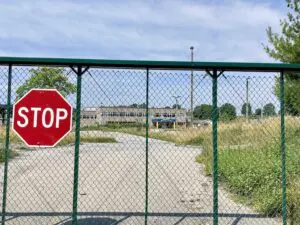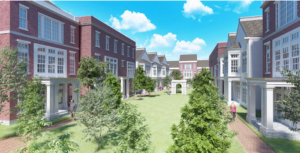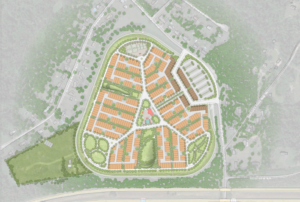Fishkill officials pan housing proposal
As part of Gov. Kathy Hochul’s quest to build 15,000 homes and apartments to address New York’s housing crisis, the state on June 21 announced that Conifer Realty has been selected to redevelop the shuttered Downstate Correctional Facility just north of Beacon.
The Rochester-based company said it will convert the 80-acre former maximum-security prison in the Town of Fishkill over the next decade into a mixed-use campus with community space and up to 1,300 housing units.
Downstate, which opened in 1979, sits north of Interstate 84. It was among a half-dozen correctional facilities closed by the state in 2022 due to declining inmate populations. It is the first of those facilities with a redevelopment plan.

Conifer’s project must be approved by Fishkill and the Empire State Development director. Town Supervisor Ozzy Albra, who on Wednesday (June 26) called the proposal a “bad deal for the taxpayers,” said he will request that the Fishkill Town Board, rather than the Planning Board, be named the lead agency to review the project and requests for zoning changes. The site is currently zoned for one house per acre.
An Empire State Development representative said the request for proposals issued for the site will remain open until a contract with Conifer is finalized. The agency would not say how many proposals it received.
If the Conifer plan moves forward, the first phase of construction in January 2026 would include 375 housing units, with a minimum of 20 percent designated as “permanently affordable” for households earning less than 80 percent of the area’s annual median income. (According to the most recent Census Bureau data, the AMI for a household in Dutchess County is $94,578.) The complex would include two-story duplexes and triplexes, with at least 25 percent having three bedrooms.
As much as $8 million in state grants could be available for the project.

Conifer, which has developed more than 21,000 affordable apartments in some 300 communities, said it will engage with local governments and the community to determine the housing plan for the next two phases. The first phase will be rentals but the company said it would consider selling units in the second and third phases of construction.
The state said the development would also feature a playground, a walking trail and common areas. The project advances recommendations of the Prison Redevelopment Commission, a 15-member panel created by Hochul in 2022 to consider repurposing closed prisons.
Other Prison Projects
- A minority-owned partnership was awarded the right last year to turn the former Lincoln Correctional Facility in New York City into 105 affordable housing units plus arts and community space. The prison closed in 2019.
- New York State last year issued a request for proposals to redevelop Bayview Correctional Facility in New York City, with an emphasis on housing.
- Empire State Development has transferred the Livingston Correctional Facility in Groveland to the Livingston County Industrial Development Agency, advancing another recommendation from the Prison Redevelopment Commission’s 2022 report.
The commission issued a report that year recommending that the state prioritize housing in its redevelopment efforts. It also recommended that the state launch a program to make grants available to developers and/or municipalities that acquire closed facilities, create a technical assistance fund to help with infrastructure acquisition and maintenance, and support outreach and consensus-building in impacted communities.
But Albra said on Wednesday that, if the Downstate project is built as proposed, it would overwhelm Fishkill. The development “would be bigger than the Village of Fishkill, which has its own government,” he said.

Albra questioned how Routes 52 and 9D, which are often congested near the Fishkill/Beacon line, could handle an influx of residents living in 1,300 new apartments and homes, even if introduced over several years. That many residents would require a new school, and the site currently has no fire coverage, he said.
In May, the town circulated a draft of a position paper outlining its priorities for the former prison. In the document, officials argued that Downstate would be perfect for commercial development that could “be an economic driver.”
If the redevelopment is mixed-use, they requested that Fishkill and Dutchess residents, in that order, be given preference for a third of the units. The paper also advocated asking the state for help with infrastructure, such as water and sewer lines and police coverage. Town Board members will vote on Wednesday (July 3) on a final version to send to Hochul.
Some issues raised by Albra could affect Beacon, too. The former prison is connected to Beacon’s water and sewer systems. And without a new school, children living in homes constructed at the site would attend Glenham Elementary, which is in Fishkill but part of the Beacon City School District.
At the same time, Beacon Mayor Lee Kyriacou believes the project could help stem rising housing costs. “Beacon is very popular and people are willing to live nearby,” he said. “If there were that many hundreds of units right adjacent to us, I bet it would ease up rents and pricing pressure on home purchases.”


My family and I have lived on Red Schoolhouse Road for 18 years. While we welcome more community, we are very concerned about vehicle traffic. We would like to see added bike lanes and greenways for bikes and walkers from this new development to downtown Beacon and Fishkill. Further, we hope the development will work to limit the number of cars allowed by adding robustly scheduled public transit routes. (I’m sorry Beacon Loop; your buses are already too few, far-flung in coverage and far between in schedule.)
Financial incentives or disincentives might be used to dissuade car ownership by new residents. New businesses can be supported with tax incentives for sustainable transportation, such as e-bikes, pedicabs or a Citi Bike-style rental. Whatever can be done to help Red Schoolhouse Road stay safe and keep vehicle congestion to a minimum will benefit the entire area, both long-established households along Red Schoolhouse and its tributaries, and our welcome new neighbors.
“Albra questioned how Routes 52 and 9D, which are often congested near the Fishkill/Beacon line, could handle an influx of residents living in 1,300 new apartments and homes, even if introduced over several years.” Supervisor Albra should apply that same thought process to the Fjord Trail he so enthusiastically endorses.
Rather than housing, move Fishkill Correctional into the old Downstate campus. It makes no sense to keep Fishkill Correctional in ancient buildings in need of gut renovation when it could easily move into a newly upgraded and custom-designed facility up the road. Meanwhile, the much nicer real estate that Fishkill Correctional sits on — like a death cloud hanging over Beacon High School and Matteawan Road — could be more easily converted to any number of purposes, such as a satellite campus for Dutchess Community College, mixed-use residential-retail, a sports multiplex or an aquatic center with an Olympic-size pool. The infrastructure for a new exit off Interstate 84 — which is where the $8 million should be spent — at Heritage Financial Park already partially exists and would feed the updated hilltop development on the east side and the newly upgraded stadium on the west side. With easier access to the stadium from the highway and Beacon, that stretch of 9D could be incentivized enough to achieve full development, which would increase the infusion of economic activity and ease some of the worst and most dangerous traffic congestion along that stretch while increasing the housing supply in a more modest and manageable way for the Beacon school district to absorb. There’s nowhere to add an exit on Red Schoolhouse and there’s nowhere else to dump traffic from 1,300 units, all of which will be dependent on driving to get to work, school and most shopping. The Hudson Valley isn’t just… Read more »
It’s totally irresponsible to not first completely exhaust the possibilities of repurposing the existing facilities in whatever creative way necessary to avoid the destruction of all that existing functional infrastructure, laying waste to all those materials and embodied energy, and squandering $8M just in the process of wiping it all away. But New York State isn’t looking for creative reuse here, and isn’t interested in uses that don’t advance their own agenda. I suspect that the State’s push for housing construction is quietly motivated by an anticipated influx of climate migrants over the next couple of decades, and considers the obvious negative local impacts as the cost of serving this higher purpose. I expect to see a similar, though smaller, housing project proposed for the Beacon Correctional Facility in the near future.
The infrastructure in the area needs to be upgraded before housing can be considered. Routes 9D and 52 already cannot handle the congestion from I-84 and Heritage Financial Park. On most days when school is in session, it could take hours to go a few miles to pick up kids. The buses are late because they can’t get through the antiquated state roads with all this traffic.
This project aims to raise our taxes and burden our lives with more unneeded stress to get around our small towns, which are overpopulated already. Do something to fix our roads and traffic congestion before adding more to the pile, Gov. Hochul.
In Florida, something like this would be called a planned community and they would build retail and grocery stores and schools, not just throw up a bunch of living spaces and make the adjoining communities have to deal with the rest. Let the developer have to pay for infrastructure and everything else that they would be disrupting. [via Facebook]
Routes 9D and 52, hospitals and schools cannot handle the influx of people that this housing project will bring. [via Facebook]
Has there been any formal impact studies on this project? I am considering purchasing a home in this area and nervous about the area infrastructure and potential tax impacts.